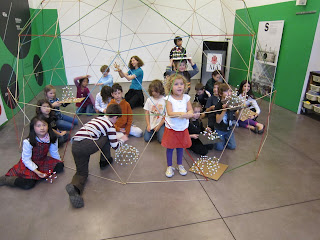CMA’s focus is purely on making art, drawings and sculpture, sound art and stop-motion animation. Their belief is that art can have a positive effect on communities.
The space is divided into "Labs" with long counters. Kids pull up stools and teaching artists offer them art materials and tips on how to use them. There is a Clay Bar for making all sorts of clay art. There is a Media Lab, where kids can film their clay art on landscapes of plastic foam or electronic bits and pieces.
There is a Sound Lab, where kids can try out electronic music scores.
There is a Sound Lab, where kids can try out electronic music scores.
This is the 2000 square foot art gallery, filled with artists’ work by Keith Haring, Freidrich Hunderdwasser, Christo and Jeanne-Claude, and a sea goddess by Swoon.
There is a Wee Arts space for preschoolers, two art labs, a Quiet Room with storybooks, and a bright yellow active space, with a webbed floor, portholes, and a ball pond, where kids can run off their extra energy. It's called The Groove Tube.
CMA has started a progam of evening classes, where older kids 13-15 years, can design fashion, study advanced filmmaking, drawing and painting.
The Children's Museum of Art is definitely where new art adventures are happening!!!
The Children's Museum of Art is definitely where new art adventures are happening!!!




































